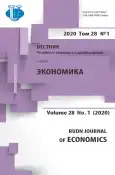Assessing methodology of banks' ratings and their competitive positions: overview of main rating agencies
- Autores: Grigorieva E.M.1, Vukovic D.1
-
Afiliações:
- Peoples’ Friendship University of Russia (RUDN University)
- Edição: Volume 28, Nº 1 (2020)
- Páginas: 23-30
- Seção: INDUSTRIAL ORGANIZATION MARKETS
- URL: https://journal-vniispk.ru/2313-2329/article/view/324101
- DOI: https://doi.org/10.22363/2313-2329-2020-28-1-23-30
- ID: 324101
Citar
Texto integral
Resumo
This paper analyzes methodologies of credit rating assessment of major rating agencies, with the focus on Fitch Ratings (Fitch). The methodology data were collected from Fitch Ratings. Also, the article review international literacy for factors and indicators adequacy in rating assessments. The purpose of this research is to overview literacy for the primary methodologies of banks' credit rating assessment. It was explained that ratios from financial indicators are most important for credit rating assessment. In some cases, in sovereign countries, support and macroeconomic factors are significant. We concluded that this area is still not enough researched and that in the future, the number of studies will appear with different methodological proposals and improvements.
Palavras-chave
Sobre autores
Elena Grigorieva
Peoples’ Friendship University of Russia (RUDN University)
Autor responsável pela correspondência
Email: aroooveo@yandex.ru
Cand. Sc. (Econ.), Associate Professor
6 Miklukho-Maklaya St., Moscow, 117198, Russian FederationDarko Vukovic
Peoples’ Friendship University of Russia (RUDN University)
Email: vdarko@hotmail.rs
PhD, Associate Professor
6 Miklukho-Maklaya St., Moscow, 117198, Russian FederationBibliografia
- Acharya, V., Drechsler, I., & Schnabl, P. (2014). A pyrrhic victory? Bank bailouts and sovereign credit risk. The Journal of Finance, 69(6), 2689-2739.
- Boumparis, P., Milas, C., & Panagiotidis, T. (2017). Economic policy uncertainty and sovereign credit rating decisions: Panel quantile evidence for the Eurozone. Journal of International Money and Finance, 79, 39-71.
- Boumparis, P., Milas, C., & Panagiotidis, T. (2019). Non-Performing Loans and Sovereign Credit Ratings. Working Paper 19-13. Retrieved from rcea.org/RePEc/pdf/wp19-13.pdf
- Brunnermeier, M.K., Garicano, L., Lane, P.R., Pagano, M., Reis, R., Santos, T., & Vayanos, D. (2016). The sovereign-bank diabolic loop and ESBies. American Economic Review, 106(5), 508-512.
- Chen, S.S., Chen, H.Y., Chang, C.C., & Yang, S.L. (2016). The relation between sovereign credit rating revisions and economic Growth. Journal of Banking and Finance, 64, 90-100.
- Chodnicka-Jaworska, P. (2019, February). Banks and Shareholders Credit Ratings - Evidence from the European Market. UW Faculty of Management Working Paper Series, (6). Warsaw, Poland.
- Cole, R.A, & White, L.J. (2012). Déjà Vu all over again: The causes of U.S. commercial bank failures this time around. Journal of Financial Services Research, 42, 5-29.
- De Moor, L., Luitel, P., Sercu, P., & Vanpée, R. (2018). Subjectivity in sovereign credit ratings. Journal of Banking and Finance, 88, 366-392.
- Drago, D., & Gallo, R. (2017). The impact of sovereign rating changes on the activity of European banks. Journal of Banking and Finance, 85, 99-112.
- Fitch. (2019). Definitions of ratings and other forms of opinion. Fitch Ratings, New York.
- Gibson, H.D., Hall, S.G., & Tavlas, G.S. (2016). How the euro-area sovereign-debt crisis led to a collapse in bank equity prices. Journal of Financial Stability, 26, 266-275.
- Grunert J., Norden L., & Weber M. (2005). The role of non-financial factors in internal credit ratings. Journal of Banking and Finance, 29(2), 509-531.
- Hassan, O.A.G., & Barrell, R. (2013). Accounting for the determinants of banks’ credit ratings. Brunel University of London Economics and Finance Working Paper Series, 13-02.
- Karminsky, A.M., & Khromova, E. (2016). Extended Modeling of Banks’ Credit Ratings. Procedia Computer Science, 91, 201-210.
- Moody’s. (2016). Rating symbols and definitions. Moody’s Investors Services, London.
- Pagratis S., & Stringa, M. (2007). Modelling bank credit ratings: A structural approach to Moody’s credit risk assessment. Working paper.
- Ryan, J. (2012). The negative impact of credit rating agencies and proposal for better regulation, SWP, Berlin. Working paper FG 1, 2012/Nr.01.
- S & P. (2016). S & P global ratings definitions. McGraw-Hill Companies, New York.
- Santos, K. (2012). Corporate credit ratings: A quick guide, the association of corporate treasurers handbook. Retrieved 19 July 2016 from https://www.treasurers.org/ACTmedia/ ITCCMFcorpcreditguide.pdf
- Shen, C., Huang, Y., & Hasan, I. (2012). Asymmetric benchmarking in bank credit rating. Journal of International Financial Markets, Institutions & Money, 22, 171- 193.
- Verster, T., De Jongh, R., Greenberg, S., Fourie, E., & De Wet, D. (2019). A motivation for banks in emerging economies to adapt agency ratings when assessing corporate credit. South African Journal of Economic and Management Sciences, 22(1), a2818. https:// doi.org/10.4102/sajems.v22i1.2818
Arquivos suplementares









